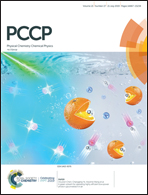The effects of H+, NH3OH+ and NH4+ on the thermal decomposition of bistetrazole N-oxide anion†
Abstract
The bistetrazole N-oxide energetic ionic salt dihydroxylammonium 5,5′-bistetrazole-1,1′-diolate (TKX-50) has attracted great interest as it breaks through the limitations of the traditional nitro group, high detonation velocity and moderate impact sensitivity. Reports show that TKX-50 transforms into the 5,5′-bis(2-hydroxytetrazole) (BTO) precursor, which is further decomposed and partly converted to diamino 5,5′-bistetrazole-1,1′-diolate (ABTOX). Studying the effects of H+, NH3OH+ and NH4+ on the thermal decomposition mechanism of bistetrazole N-oxide anion would provide a more comprehensive understanding of the TKX-50 decomposition mechanism. Herein, TKX-50, BTO and ABTOX decomposition rates, on-line analysis of the gas products, as well as quantitative analysis, are presented. It was found that the presence of two H+ decreases the decomposition temperature, whereas NH3OH+ greatly increases the decomposition rate. In the presence of NH3OH+, the bistetrazole N-oxide anion completely decomposes without producing C2N2; however, NH4+ promotes the polymerization of C2N2 generated by the bistetrazole N-oxide anion, and the amount of NO produced is greater than that of N2O. Therefore, in the TKX-50 decomposition process, the bistetrazole N-oxide anion does not receive two H+ simultaneously and converts into BTO. Furthermore, the competition between cations and their decomposition products for the H+ affects the degree of decomposition, which is important in understanding the energy release mechanism.



 Please wait while we load your content...
Please wait while we load your content...